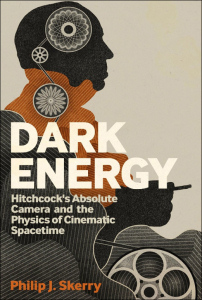Dark Energy: Hitchcock's Absolute Camera and the Physics of Cinematic Spacetime (2013) by Philip J. Skerry
 | |
| Philip J. Skerry | |
| Continuum Publishing Corporation | |
| 2013 | |
| ISBN 1441189459 (paperback) | |
Product Links
Synopsis
Alfred Hitchcock and the cinema grew up together. Born in 1899, four years after the first "official" film showing in Paris, Hitchcock demonstrated an early fascination with the new art of the cinema. He entered the film industry in 1920, and by 1925, he had directed his first feature-length film, The Pleasure Garden. His subsequent film career paralleled the phenomenal growth of the film industry during the years 1925 to 1976, the year of his last film. In the same way, Hitchcock's films paralleled the technological and scientific discoveries and inventions of the film industry: sound, color, light weight cameras and tape recorders, silent running cameras, wide screen technologies. Hitchcock experimented with all of these. Philip Skerry's book applies the theories of dark energy and neurocinematics to Hitchcock's technological genius and camera aesthetics, helping to explain the concept of "pure cinema" and providing verification for its remarkable power. Including interviews with physicists and neuroscientists, this study opens up new ways of analyzing Hitchcock's art.
Contents
- Introduction
- Science, Technology and Hitchcock
- Dark Matter, Dark Energy, and Physics
- Neurocinematics and Hitchcock's theory of suspense
- Three "Princes of Dark Energy": Uncle Charlie, Bruno, and Norman Bates
- Space and Place
- Vertigo and Psycho - The shower and the bell tower
- Conclusion
- Filmography
- Bibliography
- Index
